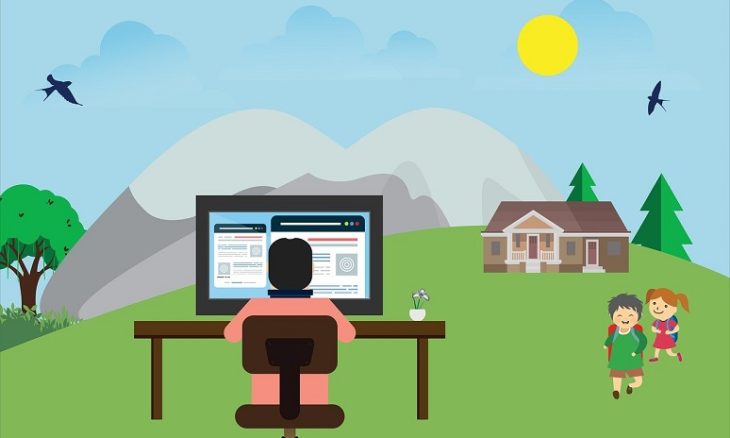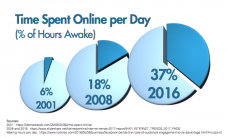When I began this series, I was focused entirely on how technology will impact life and work when the current pandemic ends. While this remains my central focus, two additional threats to work and life have added complexity to the situation:
1. The streets are filled with protesters, demonstrating for a just cause, but they are increasing the likelihood that infection will spread.
2. The President has had one too many meltdowns, and supporters are shifting positions away from him, making his re-election less likely. But fears that he will refuse to leave are rising.
The pandemic, the unrest, and an out-of-control president are overlapping issues. Braid them together and we have a Perfect Storm of particularly critical factors, making this moment in history particularly dangerous and unpredictable. What the American people do here, and how the world responds to it will shape many things to come: It is a time of fear uncertainty and doubt.

As I planned Part 2 of this four-part series, I saw the Ubiquitous Workplace, as a credible, positive piece. I saw a light at the end of the tunnel in my original outline, and two weeks ago, I had no thoughts at all that the light I saw, might be the flames of a city on fire: I could not possibly perceive that lurking in my tunnel would be phalanxes of stormtroopers in unmarked black-shirts, wielding batons at unarmed, peaceful citizens.
So I took a couple of days off, using one of them to take a long hike in the woods near my home, to enjoy the beauty, and uncloud my mind. I came home and wiped my eyes a few times. I was surprised to discover that I still see an imminent light shining on a healthy population thriving in a rejuvenated economy.
And, no I have not been inhaling.
While thinking about the near-term future, I looked backward in time to see lessons learned. Here are a few:
- Pandemics Pass. We humans have been getting devastated by periodic pandemics for the past 12,000 years, ever since we stopped hunting and gathering and started farming and settling. Then as now, we often caught infectious pathogens from animals and we have spread those germs to others. Pandemics have been many times more devastating in the past. The Black Plague killed 60 percent of the European and Asian populations in the Dark Ages before it burned itself out for many years. It then returned a few times, each time in an altered form.
- Containment Works. During the Black Plague, people discovered wearing scarves and masks reduced the risk of catching it. Wealthy people built country estates to avoid dense urban areas where the pandemic spread, so that’s when stopping the spread was invented. More recently, we discovered that the recurring smallpox pandemic could be stopped with a vaccine. My point is that today’s health officials are recommending practices that have been proven over time.
- Dissenters will die. Those who wear masks, shelter in place, practice social distancing, and use other practices are more likely to not become infected than those who defiantly party on beaches and in bars like there is no tomorrow. Eventually, there will be fewer dissenters and the current pandemic will subside, perhaps to come back in a different form at some later date. Hopefully, we will be better prepared next time.
- Golden Eras usually follow bleak times. After the Medieval Plague, Gutenberg invented his press, and a Renaissance rapidly evolved. All sorts of technologies developed driving healthier, more productive, and better-educated liberated cultures. After the Civil War, interchangeable parts made factory work safer and diminished child labor. After World War 1, we drove for the first time and this delivered us into the Roaring 20s. After World War 2, we had a baby boom, and computers were invented.
My point is that this pandemic will end. As sure as day follows night it will end, as curves flatten and stores open: The only people wearing masks in banks again will be robbers. I envision a sustained period of technological entrepreneurialism, so sweeping that it might even eclipse what has happened to date in Silicon Valley.
Unfortunately, I cannot tell you just when it will start. It may be in two months as some politicians rosily predict or it may not happen for another year, as some health officials soberly warn.
No Champagne

I see no reason yet to pop a champagne bottle and start singing, Happy Days are Here Again, and personally, I fear the economy will remain in the toilet for some time to come. I favor a conservative approach to opening businesses, while I remain sensitive to those who argue urgently otherwise. I think Henry Blodget pretty much nailed it in Business Insider, when he observed, “Reopening stores during the pandemic will not fix the economy, but stopping the pandemic will.”
The trends will reverse, curves will be flat and then decline: The only people wearing masks in banks again will be robbers.
What will the world look like then? What avenues will hundreds of millions of people all over the world find to rebuild their work and lives? What new doors will open and who will be the early winners in this coming Golden Age? How will technology play a role in improving work, communications, and business opportunities? How does all this resurrect a badly damaged economy and when will our kids get to play in the schoolyard with classmates?
Like you, I can only guess.
No Crystal Ball

I am no futurist: I don’t crunch data and make snazzy graphs for presentations; nor do I believe in magic. I once thought I saw a crystal ball, but there turned out to be a goldfish swimming in it.
But I stay loyal to what they taught me in my journalism courses. I read what others write and I try to balance opposing views so that my readers can make better-informed decisions. But I have spent much of the last 20 years looking at early-stage technologies and trying to spot trends that hint of the sort of world-changing events that John Naisbitt labeled as Megatrends.
Zooming Ahead
I see Zoom Video Communications as the flagship speeding into a megatrend that I am calling The Ubiquitous Workspace. Zoom is one of several video chat platforms, a technology that has been around for at least twenty years. It is already public and on the cusp of its 10th birthday, so it’s not even a hot little startup. But it is easy-to-use, affordable, and works on just about any connected computer. It has experienced numerous glitches during its current period of rapid growth including embarrassing hacker attacks.
In my view it has recovered from stumbles, adjusted course, scaled well, and has behaved transparently. Additionally, Zoom has tons of competitors including new offerings from Facebook, Microsoft, Google, and Slack.
In this time of mostly dire financial reporting, Zoom’s numbers are phenomenal. It has grown significantly from 10 million participants-per-day before the pandemic to over 300 million daily meeting participants. Its stock is flying with 169 percent year-over-year revenue growth.
So, I think Zoom will sustain a long ramp of success as we enter what I call the Post-Pandemic Era (PPE). But Zoom’s success or failure in itself is not important to my PPE. What’s important as I see it is that mobile video communications as a category are enabling people to work, learn, share, and play in a time when they otherwise could not. Video chat has become a habit, just like social media or interactive games did in the past. It has become an essential business communication tool, just as email once did.
I believe mobile video communications will serve as an increasing part of work and life for most people moving forward. In the past few weeks, we have seen the first use of video for doctor appointments, home appraisals, ultrasound tests, and even mass layoffs.
I also think the mobile portion has greater potential than has been realized so far. But the fact that everyone will now be able to video chat with anyone, anywhere will evolve over time, in the same way, the mobile phone evolved. Only if you are of a certain age, will you recall that the original application for the mobile phone was to actually talk to people in realtime.
As important as video is becoming to most of us, it will be far more central to digital life for future generations, as I see it.
The Video Generation

Remember back in the 1980s, when there was talk about Digital Natives? It was all about the first generation to be born after personal computing became commonplace. Digital Natives developed more interdependent relations with digital devices than their elders ever did.
Digital Natives grew up to become Millennials, some of whom are now having babies that will have that sort of close relationship with mobile video: it will be their expectation to communicate in that channel.
I won’t even try to speculate on whether this is a good or bad thing from a cultural perspective, but I will say that employers, entrepreneurs, educators, entertainers, and retailers would be wise to spend the current slow times to devise innovative video strategies.
Out of the Valley

At least since the 1960s, Silicon Valley has been the global center of digital innovation. That phenomenon has spread to the entire San Francisco Bay Area. The tech sector likes to thump its chest with pride in its progressive employment policies.
When the pandemic broke out and shelter-in-place policies were announced, the tech sector was among the very first to tell workers to stay home.
Twitter, Google, Facebook, Microsoft, and even Salesforce, owner of the largest office building in San Francisco, have all announced allowing extended work-at-home programs. A couple of months later tech companies were reporting that productivity was up by 40 percent and many costs were significantly lower.
Since then, Twitter, Google, Facebook, Microsoft, and Salesforce have all announced permanent work-at-home programs.
Almost immediately an exodus began in the painfully inflated Bay Area housing market. In the past month rentals and houses for sale have flooded the market, reducing prices from 10-to-14 percent.
While history insists that housing markets in the US always rebound, this one may be different. Families have been hard-pressed to keep properties and businesses have often had to strain to pay employees enough to live.
Not only that, but there are few urban communities in the developed world who have not set up startup ecosystems, in the hope of becoming the next Silicon Valley. So far nearly all of them have achieved only tepid results at best.
But in the Post-Pandemic Era, other areas that have adequate housing, education, investment resources, and transportation systems may have better opportunities than was previously possible.
In addition, there is a new issue of excessive workspace. All the big tech companies who are encouraging work-at-home practices will now find themselves with excessive space and a paucity of entrepreneurs wishing to sublease.
I certainly don’t think that this is the end for the digital industry and the San Francisco Bay Area: But I do see the playing field getting flatter. The highly specialized tech sector of yesteryear has become an artifact. Today, every company is a tech company, and tech skills such as programming are being learned increasingly at the grade school level.
Death to Corporate Culture?
I also see these trends to start relatively lightly without much chance of stampede. Some major players including Apple, Amazon, and Nvidia will require workers to return to their offices as soon as legally allowed. Not only that, but my guess is that at least half of the people working at home would prefer to be at the office.
Productivity is not the only issue to measure and some issues are hard to quantify with data, such as corporate culture.
One of my favorite lines in my first book, Naked Conversations (2006) was, “There is simply nothing like a face-to-face meeting. Hopefully, there never will be.”

I’ve been thinking about that statement as I go through my local markets wearing a mask and facing shoppers and employees, equally disguised: I wonder if they are smiling or grimacing. A world without smiling, hugging, or fist-bumping makes me think about a world turned cold by automation as Alvin Toffler warned against in Future Shock.
Companies whose employees don’t see each other will not form the sort of corporate culture that they do now. I doubt if there will even be the same level of corporate loyalty.
This will be a high price to pay for increased productivity.
Saved by Startups
Right now, the human race is at the bottom of a deep metaphoric ravine. Our toes are at the base of a huge mountain that represents unemployment and a bleeding economy. The way we get above it is one step at a time. As we get the hang of it, we will be able to climb out faster.
This is of course not particularly good news, but it is a scenario that always inspires entrepreneurialism. Constraint creates economic opportunities.
The greater the constraints we face the more abundant the entrepreneurial opportunities will arise. More than the current tech giants, those newer, smaller, less geographically-centered will drive growth and recovery in the soon-to-come Post Pandemic Era.










